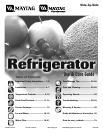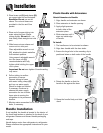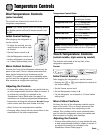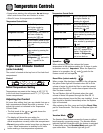
5
Connecting the Water Supply
(select models)
To reduce the risk of injury or death, follow
basic precautions, including the following:
• Read all instructions before installing ice maker.
• Do not attempt installation if instructions are not
understood or if they are beyond personal skill
level.
• Observe all local codes and ordinances.
• Do not service ice maker unless specifically
recommended in Use & Care Guide or published
user-repair instructions.
• Disconnect power to refrigerator before installing
ice maker.
• Water damage due to an improper water
connection may cause mold/mildew growth. Clean
up spills or leakage immediately!
WARNING
To avoid property damage or possible injury,
follow basic precautions, including the
following:
• Consult a plumber to connect
1
⁄4” O.D. copper
tubing to household plumbing to assure
compliance with local codes and ordinances.
• Confirm water pressure to water valve is between
35 and 100 pounds per square inch, 20 pounds
per square inch without filter.
• Do not use a self-piercing, or
3
⁄16” saddle valve.
Both reduce water flow and can become clogged
over time, and may cause leaks if repair is
attempted.
• Tighten nuts by hand to prevent cross threading.
Finish tightening nuts with pliers and wrenches.
Do not over-tighten.
• Wait two to three hours before placing refrigerator
into final position to check and correct any water
leaks. Recheck for leaks after 24 hours.
• Verify the copper tubing under the sleeve is
smooth and free from defects. Do not reuse an
old sleeve.
CAUTION
Installation
• Determine which
door needs to be
raised.
• Turn front roller
adjustment screw
(A) clockwise to
raise front corner of
door.
• If one refrigerator door has reached the limit of
its adjustment range and doors are still not level,
raise or lower the opposite door by turning roller
adjustment screw clockwise or counterclockwise.
• Check with level to verify
1
⁄4” tilt to the back for
proper door closure.
• If refrigerator is aligned and stable, replace toe
grille.
• Align the toe grille mounting clips with the lower
cabinet slots.
• Push the toe grille firmly until it snaps into place.
Materials Needed:
•
1
⁄4” outer diameter flexible copper tubing
• Shut-off valve (requires a
1
⁄4” hole to be drilled into
water supply line before valve attachment)
• Adjustable wrench (2)
•
1
⁄4” hex nut driver
Notes:
• Use copper tubing only for installation. Plastic is
less durable and can cause damage.
• Add 8’ to tubing length needed to reach water
supply for creation of service loop.
1. Create service loop with
copper tubing (minimum 2’
diameter). Avoid kinks in the
copper tubing when
bending the service loop. Do
not use plastic tubing.
2. Remove plastic cap from water valve
inlet port.
2’ diameter
minimum


















